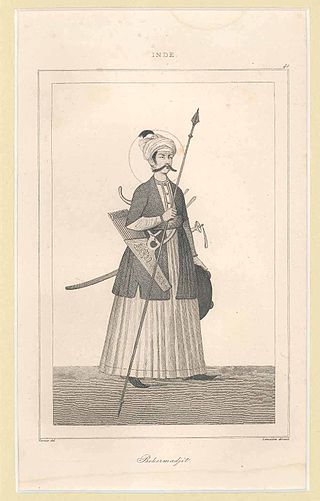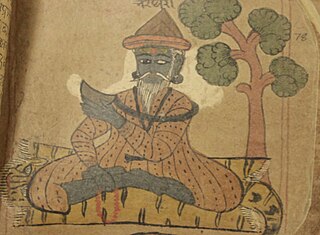
Kulottunga Chola I also spelt Kulothunga, born Rajendra Chalukya, was a Chola Emperor who reigned from 1070 to 1122 succeeding his cousin Athirajendra Chola. He also served as the Eastern Chalukya monarch from 1061 to 1118, succeeding his father Rajaraja Narendra. He is related to the Chola dynasty through his mother's side and the Eastern Chalukyas through his father's side. His mother, Ammangaidevi, was a Chola princess and the daughter of emperor Rajendra Chola I. His father was king Rajaraja Narendra of the Eastern Chalukya dynasty who was the nephew of Rajendra and maternal grandson of Rajaraja Chola I. According to historian Sailendra Nath Sen, his accession marked the beginning of a new era and ushered in a period of internal peace and benevolent administration. He was succeeded by his son Vikrama Chola

Bhoja was the Paramara ruler of the Kingdom of Malwa in central India, where his capital Dhara-nagara was located. Bhoja fought wars with nearly all his neighbours in attempts to extend his kingdom, with varying degrees of success. At its zenith, his empire extended from Chittor in the north to upper Konkan in the south, and from the Sabarmati River in the west to Vidisha in the east.

Telugu literature is the body of works written in the Telugu language. It consists of poems, short stories, novels, plays, and song lyrics, among others. There is some indication that Telugu literature dates at least to the middle of the first millennium, the first extant works are from the 11th century when the Mahabharata was first translated to Telugu from Sanskrit by Nannaya. The language has experienced a golden age under the patronage of the Vijayanagara Emperor-Poet Krishnadevaraya.

Vikramaditya was a legendary king as mentioned in ancient Indian literature, featuring in traditional stories including those in Vetala Panchavimshati and Singhasan Battisi. Many describe him as ruler with his capital at Ujjain. "Vikramaditya" was also a common title adopted by several monarchs in ancient and medieval India, and the Vikramaditya legends may be embellished accounts of different kings. According to popular tradition, Vikramaditya began the Vikrama Samvat era in 57 BCE after defeating the Shakas, and those who believe that he is based on a historical figure place him around the first century BCE. However, this era is identified as "Vikrama Samvat" after the ninth century CE.
Vikram, also Vickram, Vickrum, is a given name of Sanskrit origin. The most common understanding of the name Vikram is valorous—one who is wise, brave and strong as well as victorious. Like many Hindu names, the name Vikram has a number of significant interpretations and connections.
Vengi or Venginadu is an Indian region in modern-day Andhra Pradesh spread over the Godavari and Krishna river deltas. The capital city of Vengi is located at Pedavegi near Eluru. Vengi was the most prominent city in Ancient Andhra for nearly seven centuries. Vengi served as the capital for Andhra dynasty like Salankayanas This region was part of Ashoka's Mauryan Empire in the mid-3rd century BCE. After the Mauryan Empire collapsed in 185 BC, the region was dominated by the Satavahanas, who were succeeded in Vengi by the Andhra Ikshvakus. Around 300 CE, the Andhra Ikshvakus were replaced by the Salankayanas. In the late 5th century, the Salankayanas were annexed by the Vishnukundinas.

Vikrama Chola, known as Kō Parakēsari Varman, was a 12th-century ruler of the Chola Empire in southern India. He succeeded his father Kulothunga I to the throne. Vikrama Chola was crowned as the heir-apparent by his father early in his life. He was appointed as viceroy of the Vengi province in 1089 C.E., succeeding his brother Rajaraja Chodaganga. Vikrama during his tenure successfully managed to check the ambitions of the Western Chalukya Vikramaditya VI on the Vengi kingdom.Vikrama Chola inherited the territories which included Tamil Nadu and some parts of Andhra Pradesh.

The Vetala Panchavimshati, or Betal Pachisi, is a collection of tales and legends within a frame story, from India. Internationally, it is also known as Vikram-Vetala. It was originally written in Sanskrit.

The Western Chalukya Empire ruled most of the western Deccan Plateau in South India between the 10th and 12th centuries CE. This Kannada-speaking dynasty is sometimes called the Kalyani Chalukya after its regal capital of Kalyani in present-day Basavakalyan, Bidar district, Karnataka, and the Later Chalukya from its theoretical relationship to the sixth-century Chalukya dynasty of Badami. It is known as the Western Chalukyas to distinguish it from the contemporaneous Eastern Chalukyas of Vengi. Before the rise of the Chalukyas, the Rashtrakuta Empire of Manyakheta controlled most of the Deccan Plateau and central India for over two centuries. In 973, seeing confusion in the Rashtrakuta Empire after an invasion of their capital by the ruler of the Paramara dynasty of Malwa, Tailapa II defeated his overlords and made Manyakheta his capital. The dynasty quickly gained power and grew into an empire under Someshvara I, who moved the capital to Kalyani.
Shudraka was an Indian playwright, to whom three Sanskrit plays are attributed: Mrichchhakatika, Vinavasavadatta, and a bhana, Padmaprabhritaka. According to the prologue of Mrichchhakatika, he was a king; according to one theory, he may have been a third century Abhira king. According to another theory, Shudraka is a mythical figure, and the authorship of plays attributed to him is uncertain. Col. Wilfred has identified him with Simuka, the founder of Satavahana dynasty and placed him in 200 B.C.

Bharatthari, also known as "Baba Bharthari" or "Jogi Sant" Bharthari in many parts of India, is the hero of many folk stories in North India. He was the ruler of Ujjain, before renouncing the world and abdicating in the favor of his younger brother Vikramaditya.

Petrifaction, or petrification, defined as turning people into solid stone, is a common theme in folklore and mythology, as well as in some works of modern literature. Amos Brown noted that "Fossils are to be found all over the world, a clear evidence to human beings from earliest times that living beings can indeed turn into stone (...) Previous to the modern scientific accounts of how fossils are formed, the idea of magicians or gods turning living creatures into stone seemed completely plausible in terms of these cultures".

A brahmarakshasa is one of a class of rakshasas, a race of usually malevolent beings in Hindu mythology. A member of the Brahmin class who engages in unrighteous deeds is cursed to become a brahmarakshasa after his death.

Hansa Jivraj Mehta was a reformist, social activist, educator, independence activist, feminist and writer from India. She was one of only two women delegates working alongside Eleanor Roosevelt in the UN Human Rights Commission 1946-48 ensuring the wording "all human beings" instead of "all men" in the Universal Declaration of Human Rights.
Sinhasan Battisi is an Indian Hindi-language adventure and fantasy television series that aired on Sony Pal. The show is based on folktales of Singhasan Battisi. The show stars Karan Suchak, Siddharth Arora, Sayantani Ghosh, Aditi Sajwan, Navina Bole and Cheshta Mehta. A sequel series Betaal Aur Singhasan Battisi aired on SAB TV in 2015.
Shalivahana was a legendary emperor of ancient India, who is said to have ruled from Pratishthana. He is believed to be based on a Satavahana king.
Jayasimha was the ruler of the Kingdom of Malwa in central India. He was the successor, and possibly the son, of the dynasty's most powerful king Bhoja. He appears to have ascended the throne with the support of the Kalyani Chalukya prince Vikramaditya VI, and appears to have been dethroned by Vikramaditya's rival brother Someshvara II.

Sripada Subrahmanya Sastry (1891–1961) was a Telugu writer from Andhra Pradesh. His predominant works include short stories, novels, literary essays. He also performed Avadhanam. He is called Adhunika Katha Chakravarthy because of his contributions to Telugu literature. He translated entire Valmiki Ramayana into Telugu prose. He ran a magazine called Prabuddha Andhra for 9 years.
Shringara-manjari-katha is an 11th-century Sanskrit-language storybook from India. Attributed to king Bhoja, it has been partially recovered from a fragmentary manuscript. It contains a frame story, in which a courtesan's mother instructs her daughter on how to deal with men of various characters, through 13 sub-stories.












